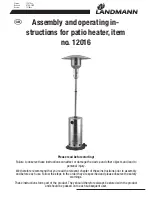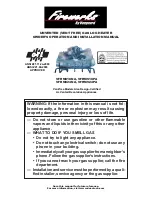
10
GKNE-SVX001B-EN
Installation
Figure 2.
Dimensional drawing - Separated combustion tubular blower unit heater
D9050B
Electrical Control Panel
Rear View
Side View
Front View
Gas Valve
Flue
1 1/8
(29mm)
E
C
P
F
D
H
32 1/2
(826mm)
B
M
G
(Discharge
Opening)
24 1/2
(622mm)
(Discharge
Opening)
33
(838mm)
A
WARNING
Do not install unit heaters in corrosive of flammable
atmospheres! Premature failure of, or severe damage to
the unit will result!
WARNING
Avoid locations where extreme drafts can affect burner
operation. Unit heaters must not be installed in
locations where air for combustion would contain
chlorinated, halogenated or acidic vapors. If located in
such an environment, premature failure of the unit will
occur!
Since the unit is equipped with an automatic gas ignition
system, the unit heater must be installed such that the gas
ignition control system is not directly exposed to water
spray, rain or dripping water.
NOTICE
Location of unit heaters is related directly to the
selection of sizes. Basic rules are as follows:
Mounting Height
Unit Heaters equipped with standard fan guards must be
installed at a minimum of 8 feet (2.4m) above the floor,
measured to the bottom of the unit. For mounting heights
above 8 feet, see
to compare unit height to heat
throw distance.
Aircraft Hangars
Unit Heaters must be installed in aircraft hangars as
follows: In aircraft hangars, unit heaters must be at least 10
feet (3.0m) above the upper surface of wings or engine
enclosures of the highest aircraft to be stored in the
hangar, and 8 feet (2.4m) above the floor in shops, offices
and other sections of the hangar where aircraft are not
stored or housed. Refer to current ANSI/NFPA No. 409,
Aircraft Hangars. In Canada, installation is suitable in
aircraft hangars when acceptable to the enforcing
authorities.
Public Garages
In repair garages, unit heaters must be located at least 8
feet (2.4m) above the floor. Refer to the latest edition of
NFPA 88B, Repair Garages.
In Canada, installation must be in accordance to the latest
edition of CSA B149 “Installation Codes for Gas Burning
Appliances and Equipment.”
Air Distribution
Direct air towards areas of maximum heat loss. When
multiple heaters are involved, circulation of air around the
perimeter is recommended where heated air flows along
exposed walls. Satisfactory results can also be obtained
where multiple heaters are located toward the center of
the area with heated air directed toward the outside walls.
Be careful to avoid all obstacles and obstructions which
could impede the warm air distribution patterns. Heat
throw distances are presented in
.
Unit heaters should not be installed to maintain low
temperatures and/or freeze protection of buildings.
A minimum of 50°F (10°C) thermostat setting must
be maintained.
If unit heaters are operated to maintain
lower than 50°F (10°C), hot flue gases are cooled inside the
heat exchanger to a point where water vapor (a flue gas
byproduct) condenses onto the heat exchanger walls. The
result is a mildly corrosive acid that prematurely corrodes
the aluminized heat exchanger and can actually drip water
down from the unit heater onto floor surface. Additional
unit heaters should be installed if a minimum 50°F (10°C)
thermostat setting cannot be maintained.
NOTICE
Unit Heater sizing should be based on heat loss
calculations where the unit heater output equals or
exceeds heat loss.











































